Launched in 1999, the Steelcase Leap v1 chair quickly rose in the ranks as the most popular chair sold by Steelcase. During the first full year of selling the Leap, it was widely reported they sold more than 5,000 chairs each week. Designed to be a high-performance ergonomic chair, it featured some of the most unique functions on an ergonomic chair for its time. This came at a cost, as it was also reported that Steelcase invested as much as 35 million into the research and development of their flagship chair.
In 2006, Steelcase stepped up their game again with the improved Leap v2. While some of the changes to the design were obvious, there were more subtle changes made as well. The Leap v1 is one of the best built chairs in the modern age, and there are plenty still available in the used market. In this post, we will cover those changes and help you decide if either chair might be right for your seating needs.
Full Disclaimer: We are an office furniture dealer and sell some of the high-performance ergonomic chairs we review. To learn more about the products we sell, our review process and why you can trust us, please visit: Why we’re different. Who is BTOD.com and The Breakroom Blog?
Steelcase Leap v1. vs. v2 Links
- Back Design
- Cushion Thickness
- Armrest Construction
- 3-Way vs. 4-Way Arm Adjustment
- Arm Pad Shape and Thickness
- Base Shape and Design
- Base Construction
1. Back Design
The first and most obvious change on the Steelcase Leap v2 is the back design. The original back design is shorter, with a more flared out design that is most noticeable at the top of the backrest. The Leap v2 comes with a taller back design.
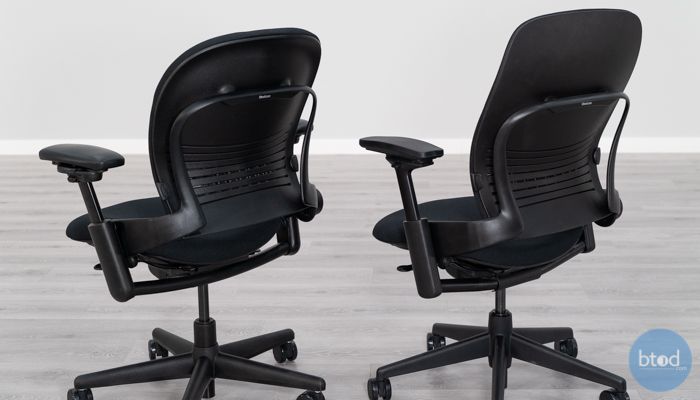
These two designs create a very different feel when seated in the chair. This is especially true for taller users. While there aren’t any uncomfortable pressure points found on the Leap v1’s design, there isn’t as good of support through the shoulder blades for taller users. If you’re looking for full back support, the Leap v2 is a better option.
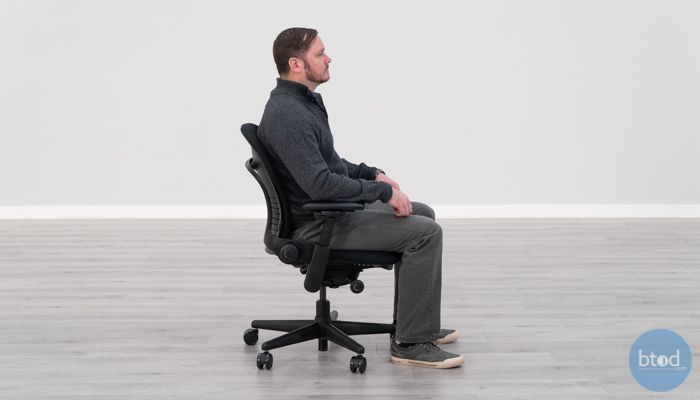
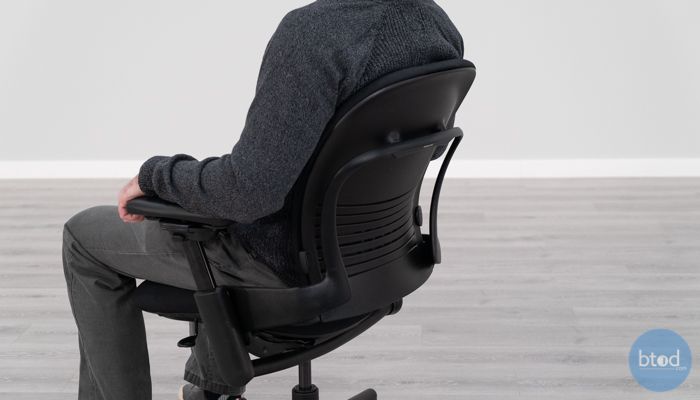
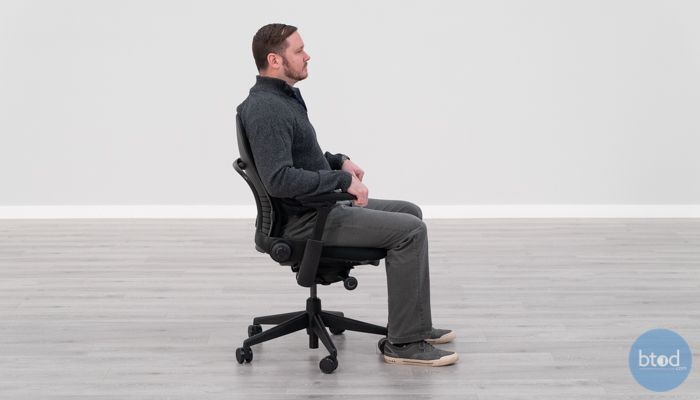
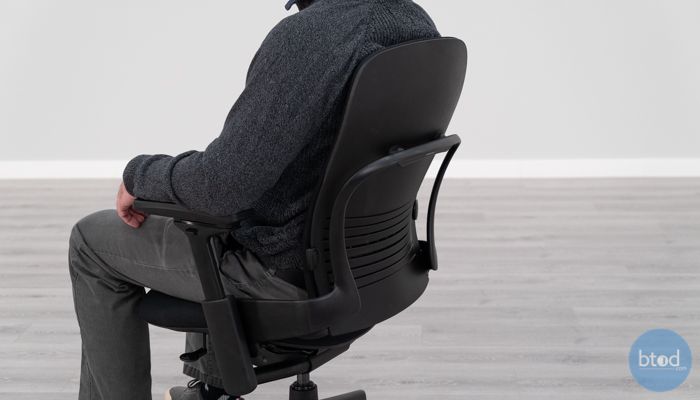
Another highlight of the curved design on the Leap v1 is that when you lean back into the chair, you get a better arch in the back. This feels like it provides a little more lower support. Both chairs have excellent lower support, but the Leap v1 seems to have a slight edge here.
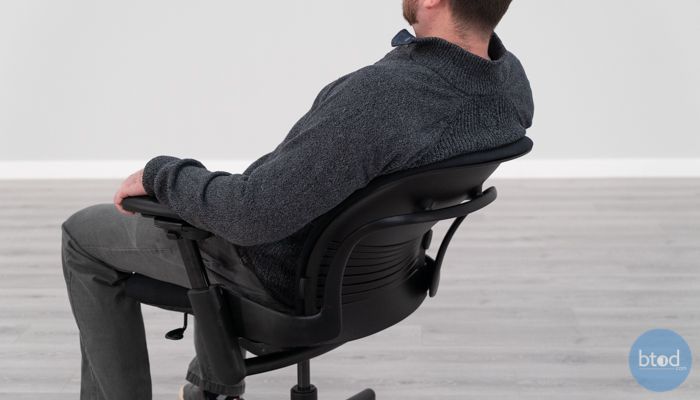

2. Cushion Thickness
The Leap v1 and v2 cushion thickness is quite a bit different, especially for each chair’s backrest. The v1 has a noticeably thicker back pad on it than the v2.
While I enjoy the thicker back pad on the Leap v1, my preferred version of the backrest is actually on the v2. The v1 has a feeling like it is hugging you a bit more, making the chair feel smaller for large frame individuals.
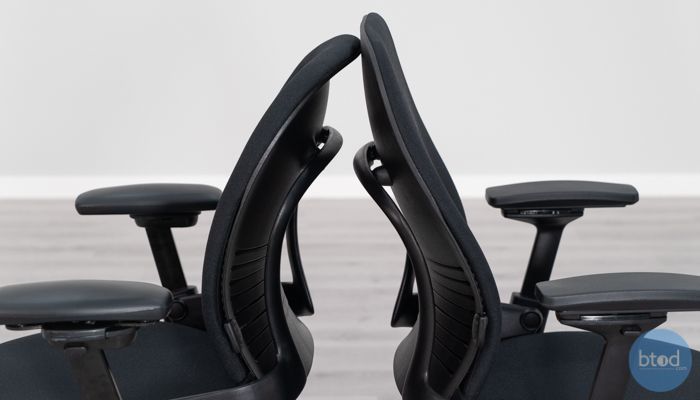
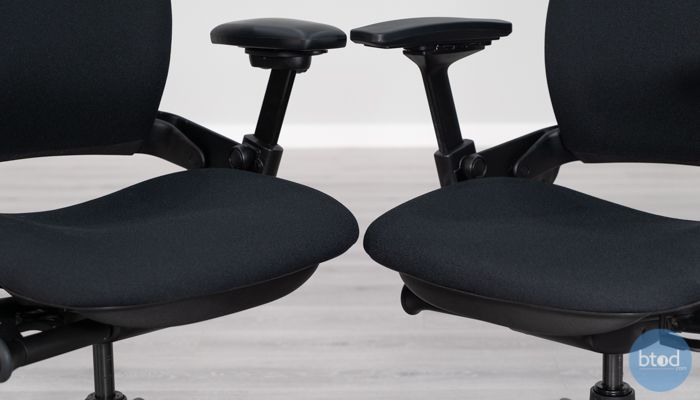
The v1 also features a bit thicker seat pad than the leap v2. The slightly different shape of the pad also accentuates this appearance of it being thicker. The only issue is that most v1’s from 1999-2006 will have lost some of their padding, so when compared to a new seat pad on a v2, it will probably feel a bit more thin from being compressed down so many years.
3. Armrest Construction
There were a handful of changes made to the Leap’s armrest from Version 1 to Version 2. The saying that they don’t make ‘em like they used to really applies here. With a steel construction for the vertical portion of the armrest on the v1, it was stout. Moving the arms up and down, the weight of the arms was noticeable, which isn’t something we find on ergonomic chairs made today.
The Leap v2 introduced plastics here, and while the plastic molds are nice, they aren’t as solid as the steel found on the original chair. When you apply weight to the armrests on the v1, they don’t have any flexing that occurs. The v2 arms don’t feel quite as sturdy, but this comes with the territory of more modern chairs.
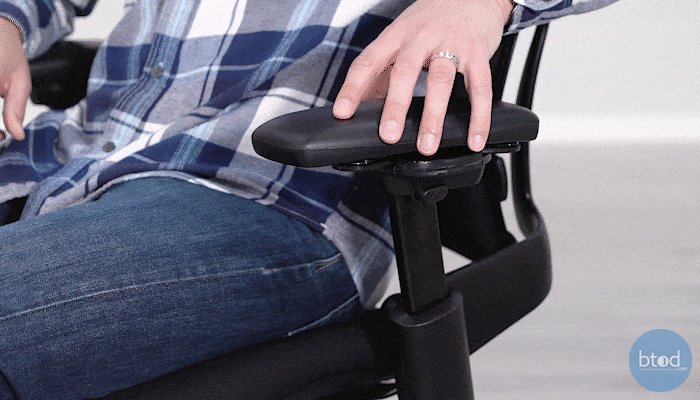
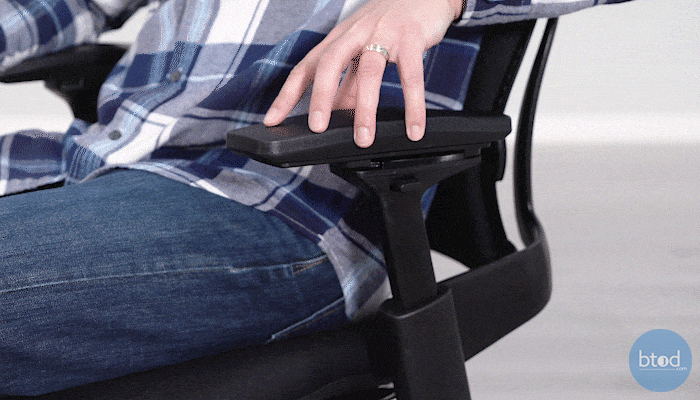
One improvement I noticed right away with the v2 was that the play in the vertical portion of the armrests was reduced. While the v1 was sturdier overall, there was quite a bit more space between the inner and outer portion of the frame design. This allows the arms to sort of rattle around a bit.
4. 3-Way vs. 4-Way Armrest Adjustment
Steelcase has an absolute lock on the best armrests in the business. The 4-way arms found on the Leap v2 are also used on the Amia and Think chair. This armrest design wasn’t something that came on the original version of the Leap though. Instead they included a 3-way armrest, which for its time was impressive.
The 3-way arms on the Leap v1 offer a wide range of adjustment. Height, width, and sliding pivot function are standard. Underneath the slide arm caps, the adjustment guide for the chair is included, which is something that carried through to the current Leap v2.
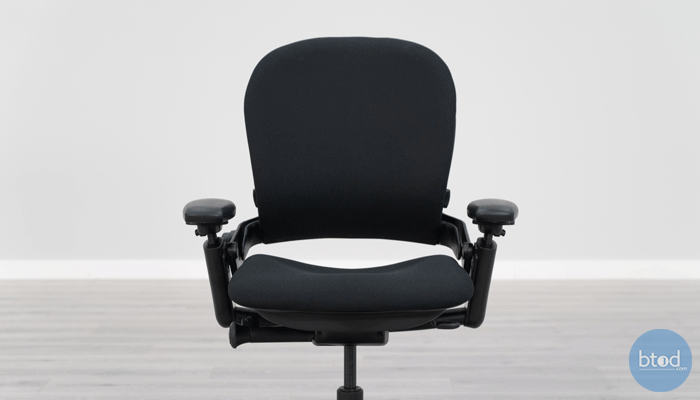

The Leap v2 introduced an important motion: depth. The 4-way armrests on the Leap v2 are second to only the Steelcase Gesture with regards to their adjustability. While this feature might not seem important, depending on how you use the chair depth adjustment is crucial to getting the right fit. This is especially true if you use a keyboard tray at your desk or like to recline.
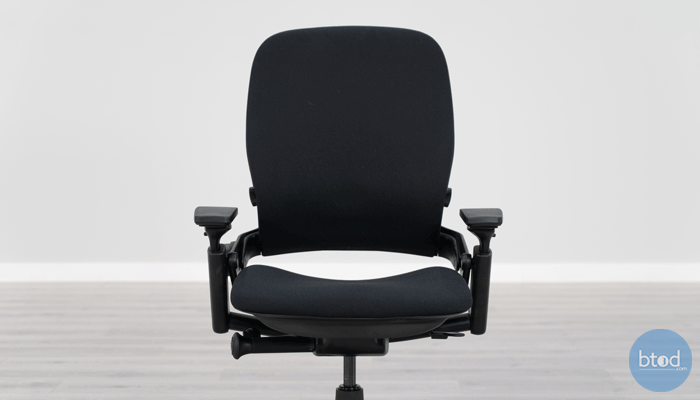

5. Arm Pad Shape and Thickness
Like the seat cushions on the v1, the arm pads are also thicker than those on the current v2 chair. The shape is noticeably different as well. Because of the thickness difference, the arms on the v1 will offer a deeper feel when putting your elbow onto the arm pads. Overall, if you’re looking for nice thick padded arms, the Leap v1 might be a better option. The look of the v2 arm pads is more appealing though, so if you’re more about aesthetics, the v2 has an edge.

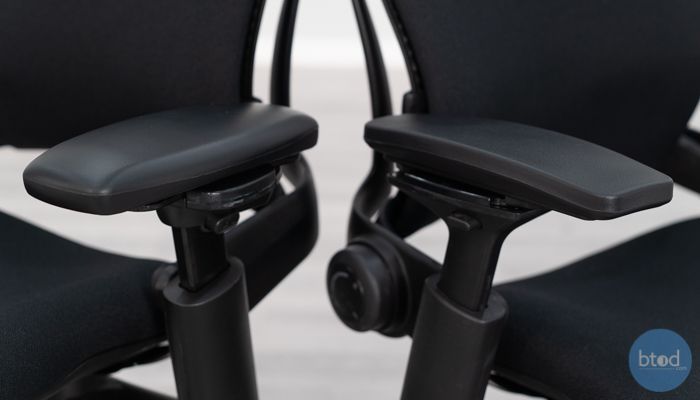
6. Base Shape and Design
By now you’ve probably concluded that many of the changes done to the Leap v2 were linked to aesthetics and finding a way to lighten the chair’s weight. The base design was another great example of this. With a more flat and rounded design for the v1, this creates a more dated look and feel. The v2 base has more height, sleeker lines, and is quite a bit thinner, creating a modern look for a chair that is still thirteen to fourteen years old.
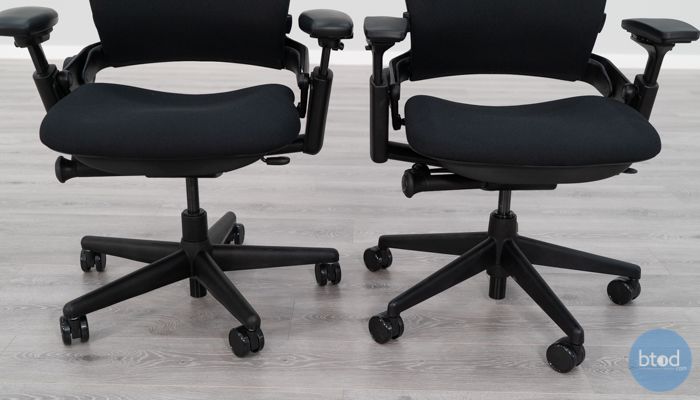
7. Base Construction
Plastics have come a long way, which has allowed many of the chair manufacturers to switch to lighter nylon plastic that creates a sleek look for the bases. The Leap v1’s base is an absolute tank, built from steel, which is something that isn’t commonly found on standard sized ergonomic chairs. This heavy design wasn’t the prettiest though, with the cheap plastic cover used to hide the steel structure beneath.
The Leap v2 uses a heavy-duty, nylon plastic design, which created a more streamlined look. Even with this change to plastic, Steelcase has kept the weight capacity of their chair at a whopping 400 pounds. They even warrant the Leap v2 for 24/7 usage. If this is the type of scenario you plan to use with the Leap, I would recommend the v1 over the v2.

Bottom Line on Leap v1 vs. v2 Chairs
The original Leap chair is still one of the best chairs in the business. Built to hold up to almost any environment, it is no wonder why people feel this work horse is one of the best built chairs to be mass produced. The only problem? The Leap v2 was introduced and provides a more modern appearance. While each chair has their advantages, after spending months in both chairs, I can confidently say the Leap v2 is a better chair for overall comfort, ergonomics, and design. This isn’t that big of a surprise, since it has been more than thirteen years since Steelcase made the last big change to their flagship ergonomic chair.
Additional Steelcase Resources





Ollie
Reading the article, it sounded to me like v1 was the clear winner. But then the conclusion declared v2 was better. I’m confused!
The Chairmeister
I bought a used Leap V2 10 years ago and sit in it on average 15 hrs per day. About 6 years ago the hydraulic up/down thing stopped working, so the chair would sink to the lowest height. I fixed this by putting a PVC pipe over the existing “pipe”, cut to the height I need. Other than that this chair shows zero signs of aging and I love it as much as ever. I’m thinking of buying another used one now which should last me the rest of my life, even though I don’t really need one yet.
Paul
Great reviews! Very thorough, and good use of images and gifts to demonstrate each point!
Tyrone
Good summary, thanks!
Bud
Like Brian above, I checked out the Steelcase website and other office furniture websites and I don’t see any reference to a “Leap V2,” just “Leap.” I do see a “Leap Plus” on the Steelcase website, though. Apparently a Leap Plus” is intended to be the same as a “Leap” but a little wider and, if I read the description and specifications correctly, intended for a heavier person (400 lbs for the “Leap;” 500 lbs for the “Leap Plus).
Based on this, I’m going to assume that unless someone explicitly says otherwise, you can’t buy a so-called “Leap V1” new. It’s no longer made. Besides, it never was called “Leap V1,” just “Leap.” It would be like in the years 1917-19 calling the war that was be fought, World War I. Nobody was counting.
Greg Knighton
The Leap v1 is the original and cannot be purchased new. These are only available used. You can find them refurbished in the used market as well.
Brian
I dont see any mention of Leap “Vx” on the steelcase store. Just Leap. I assume that the V1 was discontinued and the V2 is now just Leap.
Russ Venlos
Steelcase production has been shutdown for about two weeks due to ransom ware attack.
So good luck finding one of these.